YouTube + HTML5 = PROFIT
13 Apr 2015Everybody loves YouTube, doesn’t it? I love this service too.
I see lots of videos from it and I’m really satisfied with this service.
So, free candies and hugs for everybody, yuppie… (Notice: you can skip to the TL;DR part at the end of the page. PRO TIP: you can search for it in your browser.)
But…
Yeah, bad news here. It uses Adobe’s Flash Player. The plugin that has just been used for flash games and Youtube.
About the first of them, I can still remember some epic ones, as Burrito Bison Revenge and Robot Unicorn Attack: Heavy Metal.
For Youtube… well, it’s for Youtube.
So what…?
Actually, as you should know, Linux has outdated Flash plugin (11.2, when the upstream one is 11.7) that is stable but… well, it’s not updated, fine?
Apart from this, on my main OS (Antergos, an ArchLinux with lots of goodies in it and a fully working desktop manager) I’ve no video thumbnail when shifting the player cursor. And no default hardware accelleration. Yup. (But read below for some juice.) Also, even on Windows I’ve some problems with hardware accelleration (With my Intel Graphics, I’ve some hardware decoding issues on some formats, as 480p).
SPOILER: Nerd stuff ahead… more then usual, yes. If you’re not interested, skip to next paragraph.
Thanks to Rinat Ibragimov, it’s possible to use an updated version of Flash even on Linux; thanks to his hard work, now we have avaible a PPAPI-to-NPAPI conversion plugin that allows to use the PPAPI Chrome plugin on Firefox. If you’re interested, take a look here, while you can track hardware decoding specific stuff and progress here. This awesome developer also developed the awesome libvdpau-va-gl, that allows to use VA-API as a VDPAU backend for hardware accelleration. (As Flash just supports VDPAU for hardware accelleration… So many facepalms for me.). Translation for human mortals: you use VA-API for VDPAU accelleration = hardware accelleration for Flash on Intel graphics. Here you’ve installation tutorial for Ubuntu. Instead, for installing libvdpau-va-gl on ArchLinux you could do something in a shell like this:
# Installing required packages
sudo pacman -S libvdpau-va-gl libva-intel-driver flashplugin
# Enabling HardWare Accelleration for Flash plugin
sudo sed -i 's/#Enable/Enable/' /etc/adobe/mms.cfg
# Making avaible the driver through environment variables
echo "export VDPAU_DRIVER=va_gl" >> .bashrc
# Activate it for the actual session
export VDPAU_DRIVER=va_glNotice: in this way it’ll work just for the user which exports the variable; to make it default for the whole system, you should create a /etc/profile.d/vdpau_vaapi.sh script with this commands:
#!/bin/sh
export VDPAU_DRIVER=va_glThis will do the trick.
The solution is… HTML5!
As you should know, YouTube has made avaible an HTML5 player avaible here. This make the YouTube experience free from the problems given by Flash Player. Also, it has no problem in playing all the videos avaible with Flash, it has 60 FPS videos support (and Flash does not) and uses hardware accelleration (it should… I can’t be sure about it, as no related source code is avaible, but it should use hardware accellerated HTML5 canvas).
But… #2
Actually, it fully works just on Chromium/Google Chrome…
 While on Firefox…
While on Firefox…
 And on Windows Firefox
And on Windows Firefox

The final solution (TL;DR)
In order to have a fully working HTML5 YouTube player in Firefox, you just have to open the internal configuration here (Remember, just for Firefox), press the big “Yeah, I’ll be a fine boy” button (can’t remember the proper English text, sorry) set the flags shown below as suggested (PRO TIP: you can use the built-in search bar):
media.mediasource.enabled: true
media.mediasource.mp4.enabled: true
media.mediasource.webm.enabled: true
media.mediasource.youtubeonly: true
media.fragmented-mp4.enabled: true
media.fragmented-mp4.exposed: true
media.fragmented-mp4.ffmpeg.enabled: true
media.fragmented-mp4.gmp.enabled: true
media.fragmented-mp4.use-blank-decoder: falseAnd finally…
Firefox on ArchLinux
 And on Firefox on Windows.
And on Firefox on Windows.

The end
Well, that’s all folks for now. If it’s interesting, show some love and press the share button I’ve put below and thank you for reading up to this point. See you guys!